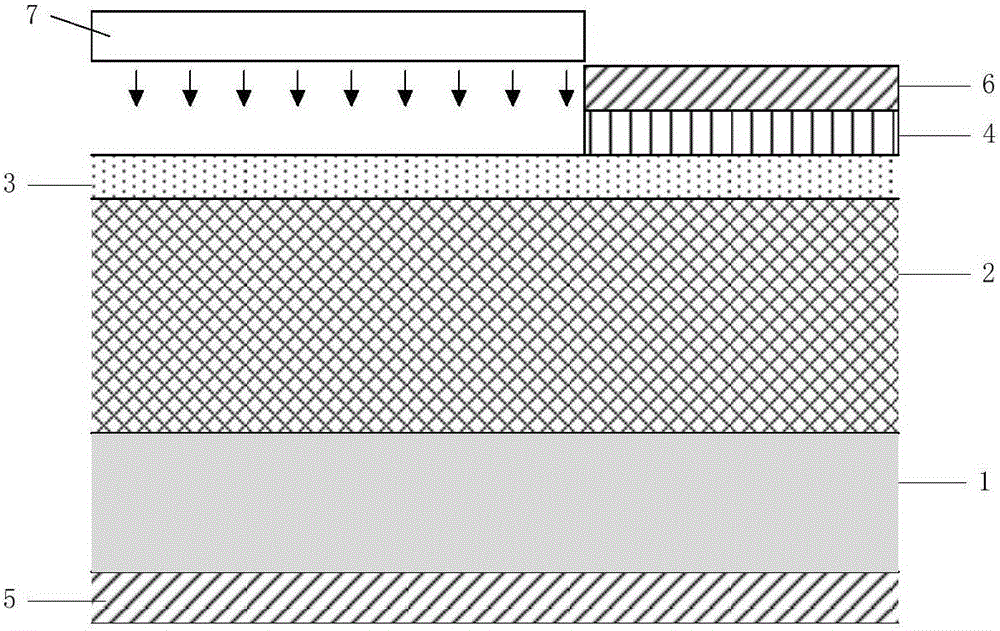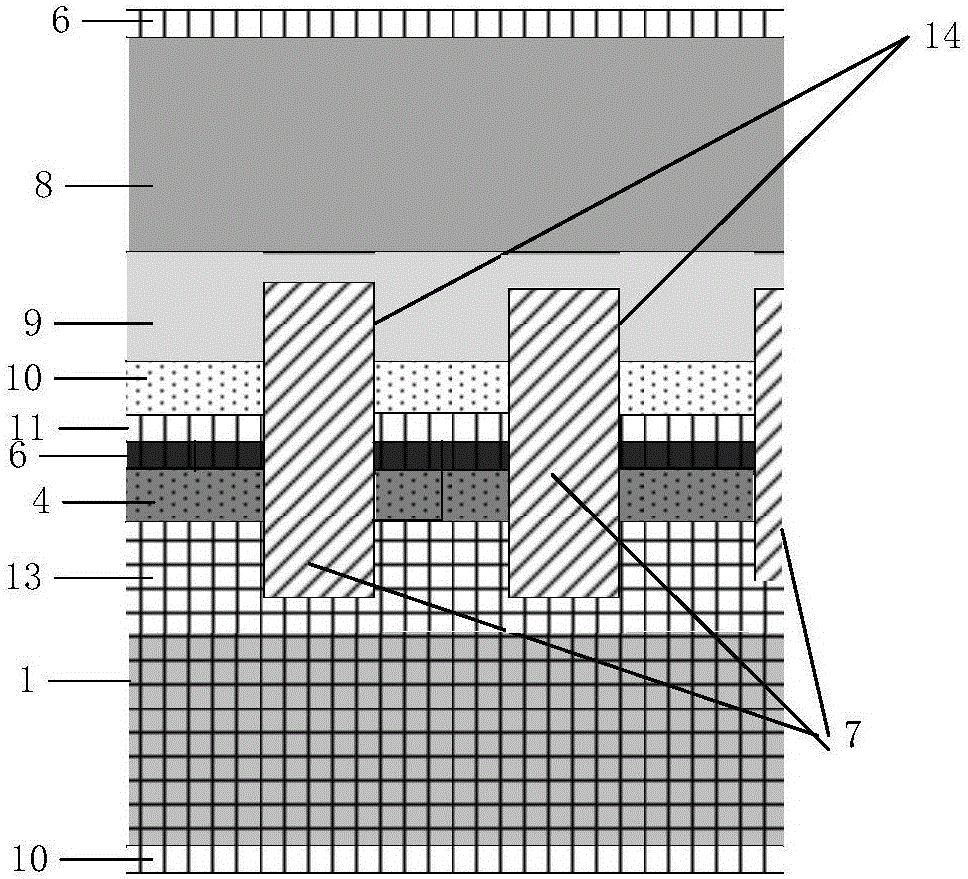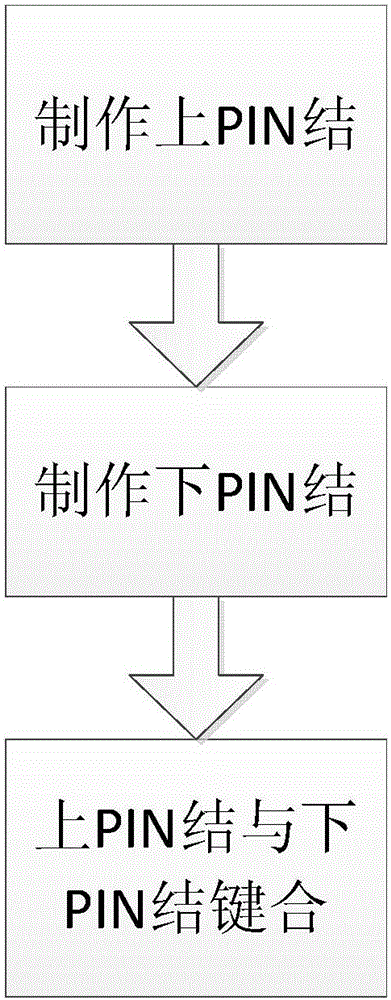Series pin structure α irradiation battery and preparation method thereof
A tandem battery technology, applied in the field of microelectronics, can solve the problems of low energy, low energy of β-rays, and limiting the output size of β-irradiated batteries, so as to prolong the service life, have good anti-radiation characteristics, and improve the energy collection rate Effect
- Summary
- Abstract
- Description
- Claims
- Application Information
AI Technical Summary
Problems solved by technology
Method used
Image
Examples
Embodiment 1
[0058] Embodiment 1, preparation α radiation source is Am 241 , a tandem PIN structure α-irradiated cell with two trenches.
[0059] Step 1: Make the upper PIN knot.
[0060] refer to Figure 4 , the implementation of this step is as follows:
[0061] (1a) Clean the P-type highly doped SiC substrate to remove surface pollutants, such as Figure 4 As shown in (a):
[0062] (1a.1) Set the doping concentration to 1x10 18 cm -3 The P-type highly doped SiC substrate in NH 4 OH+H 2 o 2 Soak in the reagent for 10 minutes, take it out and dry it to remove the organic residue on the surface of the sample;
[0063] (1a.2) After removing the surface organic residues, the P-type highly doped SiC substrate was treated with HCl+H 2 o 2 Soak the sample in the reagent for 10 minutes, take it out and dry it to remove ionic pollutants.
[0064] (1b) Epitaxial growth of P-type low-doped epitaxial layer, such as Figure 4 (b) as shown:
[0065] An aluminum-doped P-type low-doped epi...
Embodiment 2
[0099] Embodiment 2, preparation α radiation source is Am 241 , a tandem PIN structure α-irradiated cell with 8 trenches.
[0100] Step 1: Make the upper PIN knot.
[0101] refer to Figure 4 , the implementation of this step is as follows:
[0102] 1) Clean the P-type highly doped SiC substrate to remove surface pollutants. The doping concentration of the P-type highly doped SiC substrate is 1×10 18 cm -3 ,Such as Figure 4 As shown in (a):
[0103] This step is the same as step (1a) of Embodiment 1.
[0104] 2) Epitaxial growth of P-type low-doped epitaxial layer, such as Figure 4 (b) shown.
[0105] An aluminum-doped P-type doped epitaxial layer is epitaxially grown on the cleaned P-type highly doped SiC substrate by chemical vapor deposition CVD method. The process conditions are as follows: the epitaxy temperature is 1550°C, the pressure is 100mbar, the reaction gas is silane and propane, the carrier gas is pure hydrogen, the impurity source is trimethylaluminum...
Embodiment 3
[0139] Embodiment 3, preparation α radiation source is Pu 238 , a tandem PIN structure α-irradiated cell with 12 grooves.
[0140] Step A: Make the upper PIN knot.
[0141] refer to Figure 4 , the implementation of this step is as follows:
[0142] A1) Clean the P-type highly doped SiC substrate to remove surface pollutants. The P-type highly doped SiC substrate has a doping concentration of 1×10 18 cm -3 ,Such as Figure 4 As shown in (a):
[0143] The implementation of this step is the same as the step (1a) of Embodiment 1.
[0144] A2) Epitaxial growth of P-type low-doped epitaxial layer, such as Figure 4 (b) shown.
[0145] An aluminum-doped P-type low-doped epitaxial layer is epitaxially grown on the cleaned P-type highly-doped SiC substrate by chemical vapor deposition CVD. The process conditions are as follows: the epitaxy temperature is 1550°C, the pressure is 100mbar, the reaction gas is silane and propane, the carrier gas is pure hydrogen, the impurity sou...
PUM
 Login to View More
Login to View More Abstract
Description
Claims
Application Information
 Login to View More
Login to View More - R&D
- Intellectual Property
- Life Sciences
- Materials
- Tech Scout
- Unparalleled Data Quality
- Higher Quality Content
- 60% Fewer Hallucinations
Browse by: Latest US Patents, China's latest patents, Technical Efficacy Thesaurus, Application Domain, Technology Topic, Popular Technical Reports.
© 2025 PatSnap. All rights reserved.Legal|Privacy policy|Modern Slavery Act Transparency Statement|Sitemap|About US| Contact US: help@patsnap.com



